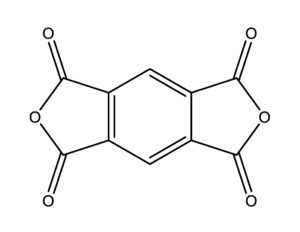
CAS Number: 89-32-7
Synonyms:
- 1,2,4,5-Benzenetetracarboxylic dianhydride
- 1,2,4,5-Benzenetetracarboxylic 1,2,4,5-dianhydride
- Pyromellitic acid dianhydride
PMDA is a solid, with a melting point of 284-288°C. It has been around since the 1950s and was initially used as a curing agent for epoxy resins. It is both highly rigid and reactive upon melting. Cured resins have a high glass transition temperature and exhibit brittleness. As a result, the use of PMDA with epoxies has been replaced by other dianhydrides such as BTDA for select applications.
Debuting in the 1960s, PMDA has now become a workhorse dianhydride to produce polyimide films and varnishes for electrical insulation. PMDA is also used in thermoplastic resin recycling processes as an additive to rebuild molecular weight.
PMDA is used in large volumes, typically 10k metric tons per year and is the nearest to a commoditized status of any dianhydride. Several manufacturers offer this molecule, with production focused in China. PMDA’s availability and pricing are subject to significant fluctuations based on the supply of durene in the global market.
RELEVANT ARTICLES
Formulating Tips for Epoxy-Anhydride Cure Systems: Benefits and Successes
Modern technology demands specialized materials that function in extreme environments. [...]
Managing Your Pyromellitc Dianhydride Supply Chain in a Volatile Market
Pyromellitic Dianhydride (PMDA) is ideally-suited as a low-cost thermal curative [...]
What is BTDA?
BTDA (3,3’, 4,4’-Benzophenone tetracarboxylic dianhydride) is a dianhydride that has [...]



